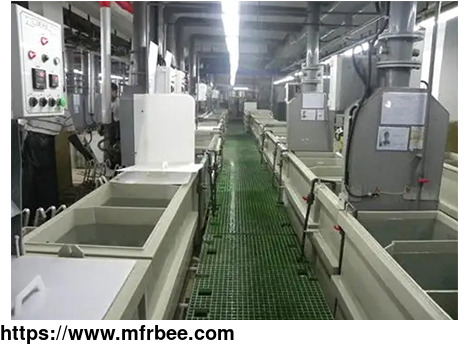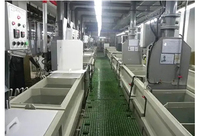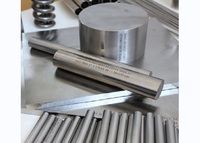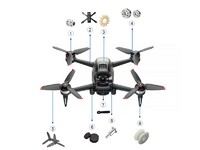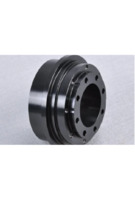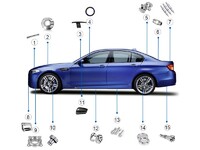SURFACE FINISHING
Specifications
The surface texture treatment requirements of special industries are extremely stringent, such as parts and products in extreme climatic environment having a level of product surface cleanliness,
types of primers, topcoats, and protective coatings. Richconn, as a professional surface finishing supplier, has a complete surface treatment plant. Metals can be sprayed with tungsten carbide,
zirconia, alumina, nitriding, carburizing, electrophoresis, vacuum coating (PVD), nickel plating, galvanizing, chromium plating, sandblasting, anodizing, Teflon spraying, fingerprint protection
coating, etc.
Surface Finishing Systems Types
1. Physical CNC surface finishing plant treatment: the method and process of surface treatment of raw materials or parts and products through physical contact. Such as: sandblasting, shot peening,
polishing, sanding, deburring, and deoxidation.
2. Chemical reaction surface finishing treatment: oxidation, electroplating, spraying, electrophoresis, printing, corrosion, blackening, bluing, etc., by electrochemically changing the surface
composition of the material to form a protective and decorative layer.
3. Heat treatment is a method of treating the substrate surface or the whole at high temperatures. High-frequency quenching, quenching, and tempering, annealing, tempering, etc. change the
hardness, welding performance and processing performance of the material. Such as gears, sprockets, molds, tool blades and other products. CNC galvanized steel surface finish is to make the
material have better performance and appearance.
CNC MACHINING CUSTOM TYPES
Anodizing
The anodization process is generally understood as energized anodization, which makes the current anode pass through gold.In the genus, the oxide solution acts as a cathode, so that the metal
surface elements produce chemical reactions to form a certain thickness.
Polishing
Polishing broadly refers to the use of metal, non-metal, chemical, electrical and other media to contact on the rough surface, and make the surface flat and smooth through friction to achieve the
effect of removing concave convex particles.
PVD Coating
PVD (physical vapor deposition) refers to physical vapor deposition. The process is divided into vacuum evaporation coating, vacuum sputtering coating and vacuum ion coating.
Powder Coating
Painting and Powder Coating are two common metal surface treatment processes.
Plating
The plating process is similar to the anodizing process, but the difference is that the plating of parts is a metal element, and anodizing only forms an oxide film on the metal surface.
Electrophoresis Coating
Electrophoresis: electrophoresis can be divided into anode electrophoresis and cathode electrophoresis. Now it generally refers to cathode electrophoresis.
Blackening Coating
Blackening: blackening, commonly known as metal bluing, is a metal surface treatment process.
CNC SURFACE FINISH TREATMENT APPLICATION
1. Packaging and printing industry: packaging surface printing, lamination, oiling; labeling of food and beverage bottles.
2. Automobile and ship industry: anti-rust, anti-corrosion, anti-acid and alkali of satin finish metal parts; internal and external decoration, shell, outer body anti-rust, anti-corrosion,
appearance decoration, etc. all need electrophoresis, anode, spray painting.
3. Ceramic industry: ceramic surface electroplating, sintering glazing, surface printing.
4. Wire and cable industry: optical fiber, cable printing, laser label, copper and polished anodised aluminium cable surface annealing, tin plating, gold plating, nickel plating.
5. CNC medical industry biomaterial industry: surface disinfection and hydrophilic treatment of surgical parts. Compatibility and harmless disposal of human implants.
6. Textile printing and dyeing industry: chemical and physical treatment of textile fibers, cotton, and linen, etc. surface dyeing, destabilizing, increasing adhesion, etc.
7. Plastic products industry: The surface plating and printing of plastic products (toys, beverage bottles, cosmetic bottles, mobile phone cases, watch cases) increase the decorative effect or
adhesion,
8. Digital product industry: printed circuit board printing, surface treatment of electronic components, etc.
9. Rubber and plastics industry: rubber surface coating, printing.
10. Glass product industry: glass surface electroplating, printing, corrosion, hydrophilicity. Such as automotive glass moisture-proof, sound insulation, refractive index, transparency and other
treatments.
11. Powder coating galvanized metal processing and equipment manufacturing industry: surface quenching and tempering, quenching, annealing, oxidation, blackening, spraying, etc. of powder coated
paint for metal parts and equipment as a whole change the properties of surface metal materials. Or increase the hardness, improve the corrosion resistance, wear resistance, or change the
appearance effect, etc.12. Aviation and aerospace industry: special materials and special surface treatments can enable the surfaces of aviation and spacecraft to withstand high temperature, high
pressure, and high torque.
CNC SURFACE FINISH TREATMENT ADVANTAGES
1. Metal nose radius and surface finish makes the material or product have better performance and appearance, such as the PVD vacuum coating of the iPhone shell and glass, so that the glass is more
wear-resistant and beautiful, and the middle frame is not easy to scratch and fall off the paint;
2. Grinding surface finish improves the mechanical properties, chemical properties and reaction properties of materials; reduce surface resistance. Such as mold steel material quenching and
tempering, reducing roughness, making the product harder, friction-resistant, and low-damping.
3. Plastic surface finish improves the production speed of parts or products, shorten the production cycle and reduce costs.
How to Choose the Right Surface Finishing Types?
Every surface finishing has its advantages and disadvantages, so choosing the right CNC surface finish depends on what features match your part requirements and application.
It’s essential to evaluate the functional and aesthetic characteristics of CNC finishes and coatings you need, and to consider how your part will interact with adjoining components. Whether or not
your part will be subject to repeated or intense friction may sway your decision.
Also, remember to take into account your part operational environment. You may believe your part doesn’t need robust resistances, but the environmental facts might require a more intensive surface
finish than you previously thought during the design phase.
CNC Machining Materials
CNC PLASTIC MACHINING
The machines used in CNC plastic machining are milling machines with 3/4/5 axes with digital control. The multi axis machining are automated and controlled by a computer that determines the path of
the cutter according to the 3D file to be created.
CNC METAL MACHINING
Before our processing and production, through the optimization design of our engineers and the use of a variety of tooling fixtures, the production cost and processing time of our OEM precision cnc
machining will be reduced. The machines we use are mainly 3-axis, 4-axis, and 5-axis CNC machining centers. In Shenzhen, we can easily purchase all kinds of high-quality metal materials in CNC
manufacturing companies, which are controlled by computer programs based on three-dimensional file control graphics.
CNC MACHINING FOR SPECIAL MATERIALS
As a professional CNC machining parts company, Richconn provides OEM CNC machining services for ceramics, carbon fiber, titanium alloy, tungsten steel, and other special materials.
- Country: China (Mainland)
- Business Type: Manufacturer
- Founded Year: 2003
- Address: 1212, Zehua building, intersection of Longhua Meilong road and donghuanyi Road, Songhe community, Longhua street, Longhua District, Shenzhen,GuangDong,China
- Contact: richconn cnc
